
Ant behaviour to solve urban problems
We can imagine that you think of ants as those annoying little insects that mess up your garden and
infest your kitchen. But did you ever consider how amazing ants are? They are everywhere, not only in
your garden. They can be found in most terrestrial habitats: in tropical and warm-temperate habitats,
and from deserts to forests(1). Ants are social insects, and their behaviour may be of help to us. The
increase of the human population has caused rapid urbanisation and cities are becoming more
crowded every day. This can lead to logistic problems, such as traffic jams and the collection of
garbage. Some mathematicians and informaticians use the behaviour of ants as a source of inspiration
for designing mathematical models called 'ant colony optimisation algorithms' to solve these
problems. Before we go into more detail about ant colony optimisation, we will first introduce you to
the wondrous world of ants. There will be a short introduction to the ecological importance of ants
and why they have become such a successful family. After that, we will look at their behaviour. Finally
we will discuss the principles of swarm intelligence, self-organisation and ant colony optimisation
algorithms and how they can help solve urban problems.
Ecological importance and success
Ants are Arthropods, the largest existing phylum. Arthropods owe their success to their exoskeleton, segmented body parts, appendages en nervous system
(2). The taxonomic family of ants, the
Formicidae, originated around 100 million years ago. In comparison with the extant mammalian orders
they are relatively old. Contrarily, when compared with other families in the Hymenoptera, the order of
insects to which ants belong, they are not exceptionally old or successful; 25 of the 36 Hymenoptera
families that are known from Cretaceous fossils are still extant. To determine whether ants truly are a
successful family we will take a look at their longevity: the persistence of the phylogenetic lineage
relative to other lines that originated at about the same time and occupied about the same habitat.
According to E.O. Wilson (1987), the world's leading ant expert, longevity depends on four aspects,
which we will consider here.
The first aspect of longevity is the number of species generated through time. When one common
ancestor produces several species that inhabit many similar ecological niches, it is considered more
successful than when a line survives as a single species. This is because a lineage with several species has
'balanced its investments': more species means that it is more likely that one will survive if others fail, so
there is a higher probability of survival for this phylogenetic lineage. The estimated total of ant species is
approximately 20 000 (1,3), which can be considered to be highly diverse, compared to for example the
family Hominidae with seven species (including ourselves)(4).
The second aspect is whether derivative lineages occupy a unique ecological niche. When this is the
case, a phylogenetic lineage is less likely to suffer from competitive exclusion. Ants occupy several
unique niches. There are the fungus-growing ants that use symbiotic fungi for food, the army and driver
ants that predate on larger prey and the many species that keep other insects as cattle in their nests(1).
The third aspect is that the population density can be sustained for long periods of time. The larger the
population, the greater the longevity and the higher the fitness of a population because there is less
inbreeding. Ants are well known for their high population density, even in comparison with other insects(1).
The last aspect is the size of geographic range. The wider the range of a taxon, the more likely it is that it
will be able to adjust to changing circumstances. This aspect of longevity certainly applies to ants,
because ants are widespread, from the Arctic Circle to the most southern parts of South America, Africa
and Australia(1).
Why are ants so successful?
It can be said that the ants are a pretty successful family of insects, but what biological traits do ants
possess that make them so successful? An important characteristic is that ants are eusocial and are able
to communicate with each other using pheromones, which you will learn more about in the next
section. What makes ants stand out from other eusocial insects, like bees, is that they were the first
group of predatory eusocial insects that lived and foraged primarily in the soil and ground litter. By
occupying this niche early on, it is possible that they prevented other organisms from occupying it(1,4).
Ants have two distinct adaptations that make them suitable for their way of life. Firstly, they have
elongated mandibles that they can use as working tools. Most species have mandibles in the form of a
blade whose inner border is lined with a row of sharp teeth. They can be used for cutting and gripping.
Some species have altered mandibles that resemble a sickle or other shapes and are used as fighting
instruments (1;4). See figure 1 for some examples.
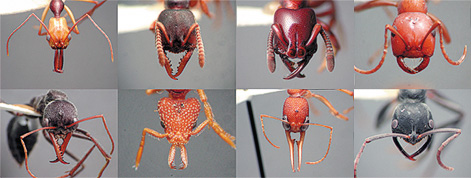
Figure 1:
The different shapes of the elongated mandibles shown for various species of ants. From Schmidt, C.A.
(2004) Morphological and functional diversity of ant mandibles. Source.
Additionally, many ants have metapleural glands, a pair of cell clusters in the middle portion of their
body that produce an antibiotic substance. These glands are unique for ants and they protect them and
their nests against fungi and bacteria, which grow in the moist environment where most ant species live
(4).
Ecological importance
Ants are an important part of the ecosystems they live in, since they constitute a large part of the
biomass and they function as ecosystem engineers. This means that they shape the environment they
live in by directly and indirectly affecting the flow of energy and material(6). For example, the leaf-cutter ants harvest leaves, flowers and fruit from plants and bring them back to their underground
fungus gardens (Figure 2). Unusable material is transported out of their gardens. Instead of just rotting
away on the ground of the forest, the nutrients and energy are transported through the ant colony(7).
Their big appetite is a useful characteristic in our urban ecosystem because they may consume the food
waste we leave behind! A recent study suggests that ants, along with other arthropods, can remove
roughly 60 000 hot dogs per year! And this is only in two well-known streets in Manhattan: Broadway
and West Street(8).
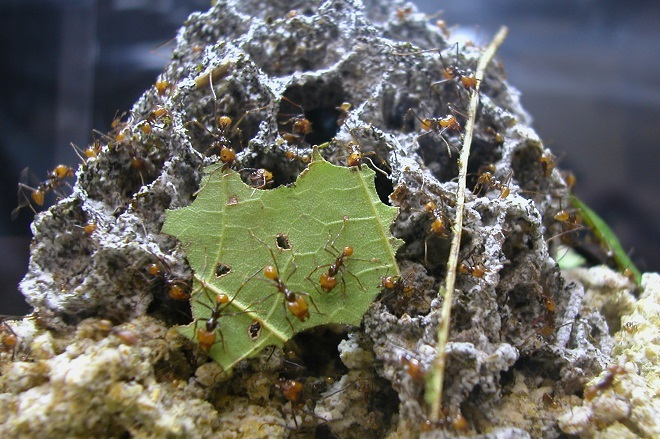
Figure 2:
Leaf-cutter ants cultivate fungi which produce enzymes to break down biomass for the ants. Leaf-cutter ants teach researchers about biofuel production. From Lynch, A.D. (2013) Leaf-cutter ants teach researchers about biofuel production.
Source.
Behaviour
When you are watching the ants in your garden, you might have noticed that they walk in lines, interact
with each other and go back and forth to the nest. Their behaviour is being studied intensively by
various research groups, and we will show you which behaviour is the inspirational source of the ant
colony optimization algorithms.
Colony life
To understand the behaviour of ants, it is important to be familiar with the way they live. All ants live in
colonies and are divided into different castes. The size of the colony varies among species, and can
range from 30 to a million ants. There are even species that form supercolonies that can consist of 20
million to more than 300 million ants, depending on the species(5)! Most of the ants in the colony are
female, of which the queen is the most important one. Her only goal is to reproduce. In most ant
species, the female offspring are sterile workers that do all the work and maintain the colony by feeding
the queen and her offspring, building the nest and defending the colony. Some female offspring are
reproductive and become new queens, which fly away and leave the colony to start a new one. Like
queens, the only goal of the male offspring (drones) is reproduction. They can fly and leave the colony to
mate with a queen, after which they usually die(5). Figure 3 shows an ant nest with a queen and female
workers.

Figure 3:
A queen (the big ant) and female workers (smaller ants) taking care of the larvae (white ovals). Adams,
E.S. (n.d.) Adams: Research Projects.
Source.
Eusociality
Ants are eusocial insects. According to E.O. Wilson (1990), a species is eusocial if the following criteria are met:
1. The adult members of the colony belong to two or more overlapping generations.
2. The colony members cooperatively care for their young.
3. The colony is divided into reproductive and nonreproductive castes.
How are these criteria met by ants?
First of all, ants stay in the colony where they were born, even as adults. This means a colony consists of
several generations. It also means that the older ants can help raise their siblings, which brings us to the
second criterion of cooperative brood care. Not only the older generation, also the younger generation
take care of the offspring. This 'caretaking' can consist of searching for food, feeding the offspring or
protecting them from threats. Thirdly, ant colonies have one or multiple reproductive queens which are
fertile and can produce offspring. The female worker ants are sterile(5).
Eusocial behaviour is an important reason why ants are such successful organisms, because it makes
foraging for food and defending their nests easier, and it makes it possible for them to divide these big
tasks into smaller tasks. The smaller tasks can be divided amongst specialised groups of workers (for
example foraging, brood care, nest building) so they can perform them simultaneously instead of step-
by-step. The groups of workers are sorted by age, body form or both, which means that every step of a
task can be carried out by a specialised group(5).
Foraging behaviour
The ant colony functions like a well-oiled machine and their foraging behaviour is a great example of
this. A part of the worker caste females are designated foragers and they collect food for the colony.
They do this very effectively because they usepheromones, which are secreted from glands, to
communicate with each other.
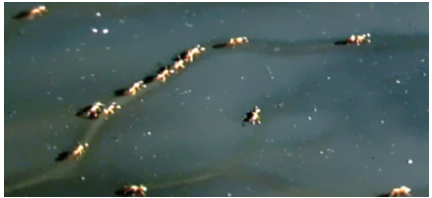
Figure 4:
Pharaoh's ants following a trail of pheromones. The pheromone trail has been made visible by letting the
ants walk on smoked glass. Source: Jackson, D.E. & Ratnieks, F.L.W., (2006), Communication in ants, Current
Biology, vol. 16, no 15, pp 570-574.
There are several types of pheromones for different communication signals. For example, trail
pheromones, that mark a trail that leads to food (figure 4) and alarm pheromones, that send out a signal
to warn the colony of danger. Ants can also recognise ants of their own colony by their odour.
For chemical communication to lead to a response, the concentration of the pheromone needs to be
above the threshold concentration at which the receiving ant responds(5). Pheromones are volatile,
which causes the signal to fade out over time, leading to a decrease in response. On the other hand,
positive feedback can lead to an increased pheromone secretion, which causes the signal to be
reinforced.
When a forager starts searching for food, she will chaotically move around in loops and twists around
the nest site, because she does not know where the food source is and there are no pheromone trails
yet. The forager cannot go too far and has to return to the colony at a certain point to feed herself.
When she returns, she doesn't twist and turn anymore, but goes back in a straight line. She can find her
way home to the nest because ants are able to orient themselves by using the sun as a reference point,
and they can use objects in the landscape for their orientation(5,9). If she does not find food, she will
not mark the trail she walked with pheromones(10). There are always multiple foragers scouting for
food. If one of them finds a food source, there are several options(11):
1. The food source is small and can be fully taken back to the colony by the ant herself in one go.
2. The food source is large and needs several ants to bring it to the colony.
3. The food source is renewable and will sustain the colony for a long time.
In the first case, the forager will take the food and bring it back to the colony without marking her way
back with pheromones because there is no point for other ants to go to a place with no food.
In the second and the third case, the forager will take as much food as she can carry, and marks the trail
with pheromones, so that other foragers will be attracted by this signal to use the trail. Every time a
forager walks the trail, the pheromone signal becomes stronger and this will attract even more foragers
to the trail. This is called positive feedback (Figure 5).
When the food source becomes depleted, more ants will leave the site empty-handed. These ants will
not mark the trail and since the pheromones evaporate after a certain time period, the signal will slowly
fade until the source is fully depleted and no ants will use the trail anymore. This is called negative
feedback(11).
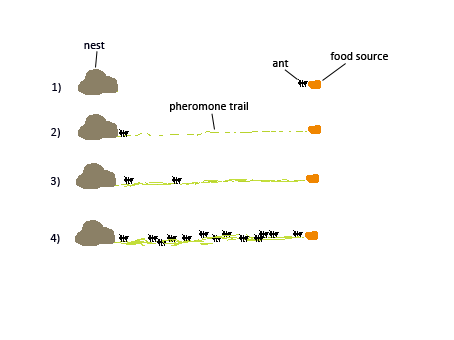
Figure 5:
Positive feedback in ant foraging. 1) First, one worker ant finds the source of food (orange). 2) Then, she
goes back to the nest (gray) and leaves a trail of pheromones (green). 3) The pheromone trail recruits other
workers, which follow the trail. These workers also deposit pheromones on their way back. 4) Eventually, the
pheromone trail will become very strong and many ants will use the trail. Source: Lotte Pronk, author of this article.
Self-organising superorganism?
The ant colony can be viewed as a superorganism. This means that the colony can be seen as one
organism and that each individual ant can be seen as a part of this organism, like cells in a body, or like
organs, which can perform specialized tasks, including reproduction(12). But one thing that is different
about this 'superorganism' compared to a regular organism, is that is has no brain. There is no central
control organ and no one is 'in charge'(13). Individual ants do not have the capacity to solve problems
the colony faces, such as food allocation, because they do not see the 'bigger picture'(14). This
establishment of order without a central or external controlling factor is called 'self-organisation'. Even
without someone telling all the individual ants what to do, the self-organising ant colony manages to
divide the work that needs to be done in order to sustain the colony, such as foraging, brood care, the
building of the nest, and defence(15).
There are a number of research groups that study this highly intriguing phenomenon. Several
components in self-organisation have already been identified(14).
Firstly, positive feedback of behaviour that stimulates the formation of a certain structure or network.
We have seen an example of this in the foraging behaviour of ants, where the marking of a food-trail
with pheromones leads to the recruitment of more worker ants, which leads to even more marking of
the trail (14).
Secondly, negative feedback is needed to counterbalance and stabilise the network(14). For example,
when the food source is depleted, the workers will stop marking the trail with pheromones on their way
back. The pheromones will evaporate, and less ants will use the path until eventually it is not used at all.
Without negative feedback, even useless paths would be used and it would not make sense to use
pheromones at all.
Thirdly, there needs to be amplification of fluctuations by positive feedback(14). The behaviour of
individual ants is said to be stochastic, which means that there is an element of chance or randomness. The fluctuations that result from this, can be amplified by positive feedback. An example of this is when
a foraging ant deviates from an established path and finds a new food source. She will amplify this
'fluctuation' by marking her trail with pheromones.
Finally, stigmergic interactions are needed(14). Stigmergy is 'the indirect communication mediated by
modification of the environment'(16). When a complex structure, like a nest, is being built, the ants do
not collectively decide they want to build a nest and they do not communicate to each other what it
should look like. The structure of the nest is formed because the individual ants react to patterns in their
environment. For example, when an ant encounters a site where a nest is being formed, it will recognise
the pattern and express building behaviour. This modifies the structure of the nest again, which will lead
to continued behaviour of nest building(14,16).
There are a number of research groups that study this highly intriguing phenomenon. Several
components in self-organisation have already been identified(14).
Firstly, positive feedback of behaviour that stimulates the formation of a certain structure or network.
We have seen an example of this in the foraging behaviour of ants, where the marking of a food-trail
with pheromones leads to the recruitment of more worker ants, which leads to even more marking of
the trail(14).
Secondly, negative feedback is needed to counterbalance and stabilise the network (14). For example,
when the food source is depleted, the workers will stop marking the trail with pheromones on their way
back. The pheromones will evaporate, and less ants will use the path until eventually it is not used at all.
Without negative feedback, even useless paths would be used and it would not make sense to use
pheromones at all.
Thirdly, there needs to be amplification of fluctuations by positive feedback(14). The behaviour of
individual ants is said to be stochastic, which means that there is an element of chance or randomness. The fluctuations that result from this, can be amplified by positive feedback. An example of this is when
a foraging ant deviates from an established path and finds a new food source. She will amplify this
'fluctuation' by marking her trail with pheromones.
Finally, stigmergic interactions are needed(14). Stigmergy is 'the indirect communication mediated by
modification of the environment'(16). When a complex structure, like a nest, is being built, the ants do
not collectively decide they want to build a nest and they do not communicate to each other what it
should look like. The structure of the nest is formed because the individual ants react to patterns in their
environment. For example, when an ant encounters a site where a nest is being formed, it will recognise
the pattern and express building behaviour. This modifies the structure of the nest again, which will lead
to continued behaviour of nest building(14,16).
In ants, an example of self-organisation is when they encounter a situation in which a path to a food
source is branched, so that they have to choose between two paths. When both paths are the same
length, all ants eventually choose just one of the two paths, even though it does not matter which path
they take. How does this happen? At first there are several ants that randomly choose a path, so both
paths will be chosen by the ants. But even though this process is random (which means that each path is
equally likely to be chosen), some fluctuations occur, which causes one path to be occupied by slightly
more ants than the other path. One of the paths will be marked with a little bit more pheromone than
the other path, and will be chosen by more ants to follow. This causes a positive feedback, which
eventually leads to all the ants choosing that one path(16).
When ants encounter paths of two different lengths, they are able to find the shortest path. This is
because the ants that have chosen the shortest path both on their way to the food source and on their
way back, reach the nest first. The shortest path is the first path to be marked with pheromones, which
causes other ants to choose this path. Furthermore, when an obstacle is put in their path, they are
capable of adapting their path and find a new shortest path around the obstacle(4,17).
The self-organised behaviour can be modulated by different factors, so that the colony can adapt to
different changes in the environment outside or inside the colony(14).
Swarm intelligence to solve urban problems
Now that we know more about ants and their behaviour, we might ask ourselves: What does this have
to do with our urban problems? In crowded cities, humans also seem to form swarms when they are
walking or driving around. By comparing this human crowding behaviour with the behaviour of ants, we
could try to solve some problems related to efficient behaviour while living in large swarms.
Swarm intelligence
Swarm intelligence is a scientific discipline that is used in fields such as computer sciences,
bioinformatics and robotics to solve complex problems in a mathematical way. It is inspired by the
behaviour of social organisms such as ants, bees, fish and birds and the principles of self-
organisation(14;18). This principle can be used to solve a number of problems, but how can the
behaviour of ants specifically be of use in our urban environment?
Ant-based swarm intelligence
Ant colony optimisation is a specific type of algorithm in swarm intelligence that is based on the foraging
behaviour of ants. Ants are capable of finding the shortest path from their nest to a food source with the
use of pheromones. In ant colony optimisation, artificial ants are used. They are programmed to carry
out an algorithm that simulates the behaviour of ants. In the programme, they deposit artificial
pheromones on a graph that represents the problem that needs to be solved. The better the quality of a
particular solution is, the more pheromones the artificial ants deposit on the graph(19). Though this
might be a little difficult to imagine, let us take a look at some applications.
Travelling salesman problem
The travelling salesman problem is a well-known, intensively studied optimisation problem in computer
sciences, which deals with finding the shortest possible tour between a set of cities, whereby you visit
each city in a given set exactly once(17,20). One way of trying to solve this problem is using ant colony
optimisation, which works like this:
A graph with fixed dimensions is programmed, on which you can place cities and artificial ants that can
move over trails on the graph. The trails represent the roads that the ants can use to reach the next city
and every trail starts with the same amount of pheromones. A number of ants are placed on randomly
selected cities. With each timestep, the ants move to another city and the pheromone trail is multiplied
by an evaporation fraction. This simulates the evaporation of the trail. When every ant has reached a
new city an extra amount of pheromone trail is added to the tour of the ant that made the shortest
walk. This extra trail is inversely proportional to the length of path the ant has walked and thus
pheromones are deposited at a higher rate on shorter paths (Figure 6). Just like real ants, the artificial
ants prefer paths with high pheromone levels. Unlike their natural counterpart, the artificial ants can be
given extra abilities so they might be able to determine how far away cities are or they can have a
memory of which cities they already have visited(17,21). Which extra abilities and restrictions the ants
can have depends on the problem at hand.
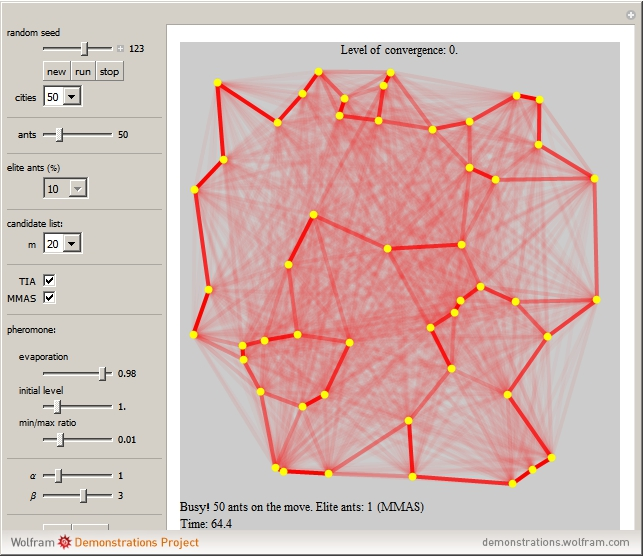
Figure 6:
Example of an Ant Colony Optimisation algorithm. Artificial ants are placed on randomly selected points in
the graph. Each path between points starts with the same amount of pheromones. After the programme is
initiated, each ant will move to another, randomly selected point. With every step the pheromone trails slightly
evaporate. When every ant has reached the next city, the path of the ant that made the shortest tour is given an
extra amount of pheromones that is inversely proportional to the length of the path. This way shorter trails will
accumulate pheromones faster than longer trails. The artificial ants prefer, just like real ants, trails with higher
pheromone levels. The programme terminates when every ant chooses the same path, which is then considered to
be (one of) the shortest possible paths.
From Kamper, R. (2012). Ant Colony optimization.Source.
Solutions to the travelling salesman problem can be applied to a number of everyday problems, where
the artificial ants can for example represent customers and the concept distance can represent traveling
time or cost(20).
These solutions can also be the basis for solving another well known computing problem, called the
vehicle routing problem. This problem searches for the best solution of transporting goods with a
number of vehicles from a depot to a number of customers(22). Since both problems deal with units
(eg. ants, salesmen or transportation vehicles) passing through points (eg. cities), the ant colony
optimisation algorithm can also be used for this problem(23). Solving these problems can be of benefit
for efficiently delivering mail, school bus routing, taxi-rides, garbage collecting and more(22). Research
on waste collection and transportation in Athens, for example, has shown that using an ant colony
based algorithm for solving this problem can decrease the driving time of garbage truck drivers greatly
and consequently can save companies a lot of time and money(24).
Mitigating traffic congestion
Another issue that is important right now is traffic congestion. The increasing vehicle population can
lead to air pollution, high fuel consumption and subsequent economic issues when traffic is not
optimally regulated. Jabbarpour et al. (2014) presented the ant-based vehicle congestion avoidance
system (AVCAS). This system is also based on the ant colony optimisation algorithm and can be used to
solve congestion problems in cities by finding the optimal usage of existing roads and their capacity. It
reduces traffic congestion by finding the least congested shortest paths and thus tries to avoid
congestion instead of recovering from it. In this way, it is not needed to build expensive and time
consuming new high-capacity streets and highways. The AVCA collects data by using roadside units, like
cameras and vehicles, as mobile sensors to predict the average travel speed of traffic and to find the
shortest or optimal path. Results from their research showed that this new system outperforms
currently used systems. Average travel time decreased by 11.5% and average travel speed increased by
13%. It decreases congestion by using alternative paths and is more efficient in handling accident
conditions (18).
Conclusion
Ants are a successful family that is estimated to consist of around 20 000 species and can be found
almost everywhere on our planet. They are eusocial organisms that live in a colony, care for their young
and search for food together. The primary reason they are so successful is that they were the first
predatory eusocial insects that lived and foraged on the ground. Furthermore, they have some
fascinating characteristics that distinguish them from other insects: elongated mandibles that they can
use as working tools and metapleural glands that protect the ants against bacteria and fungi. Their most
important means of communication is the secretion of pheromones from glands in their body. When a
worker ant finds a large food source, she leaves behind a trail of pheromones which other colony
members can use to lead them back to the source. The use of pheromones is an important component
of ant life that leads us to see the ant colony as a self-organising unit. It makes it possible for them to
solve problems without any kind of leader. This concept is applied in the discipline of swarm
intelligence, which tries to solve problems in a mathematical way by using the behaviour of social
organisms. The ant colony optimisation algorithm is an algorithm that specifically uses the foraging
behaviour of ants to solve problems like finding the shortest route for garbage truck drivers or
mitigating traffic congestions. The next time you are coming home from an enormous traffic jam and
you encounter an ant colony in your garden, perhaps for one moment, before you grab the ant killer,
you will appreciate them a little more because they give you hope that one day there will be no more
traffic jams.
Want to learn more? Why not...
- Read an amazingly thorough book about everything that makes an ant:
The ants by Holldobler, B. and Wilson, E. O. (1990). Berlin (etc.): Springer.
- Ecologist Deborah Gordon studies ant colonies and shares her knowledge in this inspiring
TEDtalk
- Deborah Gordon tells us what ants teach us about the brain, cancer and the internet in this
inspirational TEDtalk
- Consider keeping ants as pets and learn more about their behaviour from first hand experience.













